MOTORNET: Subaru Comes To The Party
Subaru Comes To The Party With New Outback And Legacy
By Karl Ferguson
Images By Neil MacKenzie - onlinefotos.com
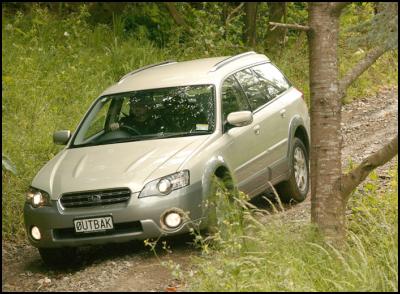
We're travelling fast. It's late and we're overdue at our expected destination. The excellent bi-xenon headlights cast large shadows on the surrounding trees and countryside as they cleave a path for us through the night. Ahead the moon lights up the narrow gravel road as it stretches out before us. The vehicle is supremely stable, cornering neutrally as we negotiate the tighter bends, our passing marked only by the plumes of dust that billow up eerily in the resuming darkness. We climb hills and crest rises with consummate ease. I couldn’t have chosen a more appropriate vehicle for this journey had I tried.
In case you were wondering, the vehicle in question is not the latest offering in the ever expanding Sports Utility Vehicle market. Even so, it is sporty and would appear to have utility in spades. But there are crucial differences. For a start, it handles much like a car. It doesn't use fuel at the rate of a small jetliner. It's pretty quick to boot. Oh, and neither does it cost an arm and a leg to purchase in the first place.
Subaru's latest Outback – and Legacy twin – have certainly come a long way. First launched in the mid-nineties the Outback effectively created its own niche market now known commonly as the crossover genre. What that means in very simple terms is that Subaru have taken a standard four wheel drive station wagon and modified it for off-roading largely by jacking up the vehicle's suspension. Not surprisingly, other manufacturers have followed Subaru's lead, most notably Audi with the modified A6 avant wagon the Allroad, and Volvo with the modified V70 wagon XC Crossover vehicle.
The original Outback was an attractive looking vehicle, but as a package ultimately flawed. Much of the problem lay in simple physics. If you raise the centre of gravity of a vehicle (usually in an effort to improve ground clearance) the trade off inevitably will always be handling. Taking this to heart, Subaru have worked diligently to ensure that the new Outback both delivers on the utility 4WD front as well as in the handling stakes. The good news is that they have succeeded - well, almost.
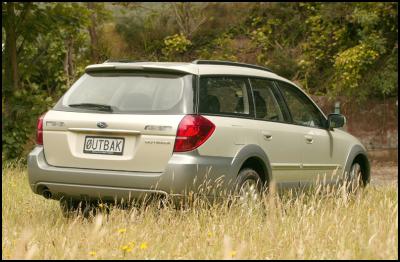
For the new models, changes to the Outback and Legacy wagon and sedan range have been more evolutionary than revolutionary. But at what point does incremental change become full fledged radicalism? The body is stiffer, stronger and larger than its predecessor. It's also lighter which, given the pressure on manufacturers to make vehicles more and more crash resistant, is no mean feat. Much of the weight saving has been gained by using aluminium on the bonnet and bumpers.
More to the point, it has a very European look and feel. The Legacy range has always had it's followers, but previously it could have been described as somewhat chunky appearance wise. Much of the bodywork that differentiated the Outback and Legacy models also looked a bit tacked on - definitely to the detriment of the Outback’s over all appearance. The new models have a more flowing, integrated look - as if the designers looked to Audi and BMW for inspiration. The rear of the car looks especially tidy, while the twin exhaust pipes emphasise the sporty heritage of the brand. Another point of differentiation with the new model is that the Outback can now be bought in either one color or two tone paintwork, again serving to de-emphasise the extra ride height that the Outback enjoys and making it appear more cohesive on the road. Previously, two tone was the only option available.
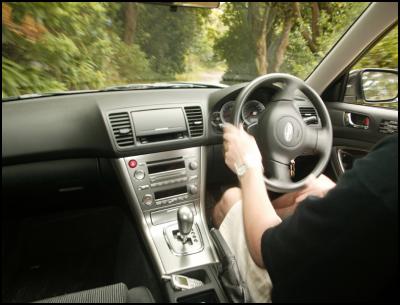
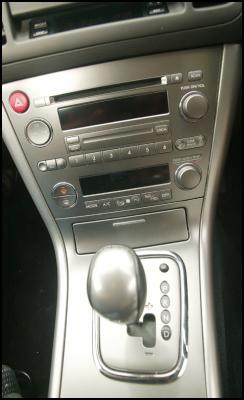
Inside is a similar story. Fit in finish is a definite improvement over its predecessor. Top-quality materials such as the upmarket headliner, the pliable grained dash, and the patterned trim add a substantial helping of Euro chic. Front and rear seats are excellent for comfort, while interior head and legroom are also up slightly on the previous model (though the actual length of the sedan and wagon has been slightly reduced). Remote stereo controls on the steering wheel would have been a nice addition though and are not uncommon in this market.
Under the bonnet, changes are also noticeable. The 2.5-litre four cylinder boxer engine of the test car has been significantly reworked producing around 120 kw at 5600rpm, up slightly on the old model. If you want something with a little more get up and go, a 3.0-litre flat six is now on offer, producing a pretty healthy 180 kw at 6600 rpm.
But even with the cooking models, performance has improved. The increase in output combined with the weight reduction means improved performance figures across the range. Expect the five-speed manual to perform better than the four speed auto. Around 8.5 seconds for 0-100 kph would not be unrealistic, an improvement of nearly two seconds over the outgoing model. Overtaking times are similarly improved. Burying the accelerator in the auto can be a slightly odd experience though. There's a momentary lag as the engine seems to gather itself before the tachometer rushes to 4000 rpm and acceleration increases accordingly. Popping the transmission into manumatic (pseudo clutch less manual) and shifting for yourself is one way around this, and a good way to appreciate one of the best aspects of the newly improved engine - the guttural howl that it emits as it runs up to the redline. Not quite as sweet as a well tuned straight six, but distinctively appealing nonetheless. Part of the problem may be the four-speed rather than five-speed auto. While a five-speed auto is standard on the upmarket 3.0R and GT models, the smaller engined cars make do with just the four-speed.
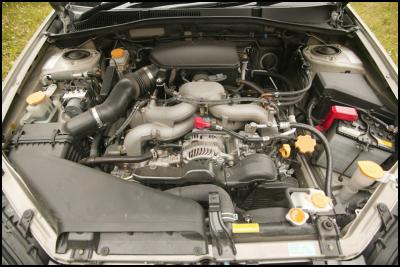
Putting the Outback through its paces, it's apparent that roadholding and handling are also much improved. Grip from the multi-purpose road and cross terrain tires is good and the Outback goes round tight corners with confidence and mostly aplomb - corners which before would have caused the Outback to heave somewhat with slightly unnerving body roll. It's only when you step into the Legacy sedan and traverse similar territory that the Outback starts to look less controlled. The soak-it-all-up suspension of the Outback is replaced in the Legacy by a firmer, shorter-travel arrangement that is somewhere between plush and firm. The lower ride height - not to mention road-purpose tires - makes for much better grip and cornering. And where the Outback's steering can feel a little woolly at the edges, either unwilling or unable to communicate directly with the driver, the Legacy's desire to change direction in a hurry improves dramatically. There's also a great deal less tendency to run wide. What that means in practice is that the Legacy (especially the sedan) makes for an exceptionally good drive, whereas the Outback has to settle for just being good.
The unifying factor in both these driving experiences of course is the standard four-wheel drive. With it comes stability, better road holding and an all round safer driving package. What potential purchasers will have to decide is whether or not the additional ground clearance of the more supple but higher-riding Outback, is preferable to the slightly firmer suspension but improved handling and road handling of the Legacy. It may come down to something as simple as whether you need to tow a boat in and out of the water, or like myself, negotiate the odd metal/gravel road.
Another question for purchasers will be how to tackle the price tag. A 2.5 litre manual sedan starts at $44,990 with the wagon adding a further two grand. The Outback 2.5 starts at $45,990 again adding two grand for the auto option, while the auto only 3.0R starts at $54,990. Compared to similar sized sedans and wagons, not exactly cheap. But, factor in the 4WD and consider the costs of similar sized SUVs and the numbers begin to look a lot more attractive.
Incrementalism then or revolution? Hard to say, but certainly this Subaru sets a new benchmark for the brand. Whichever takes your fancy, given the clear and demonstrable advantages that the Outback and Legacy range enjoy over numerous, larger and costlier SUVs, it may well be a clear case of drivers having their cake and eating it too...
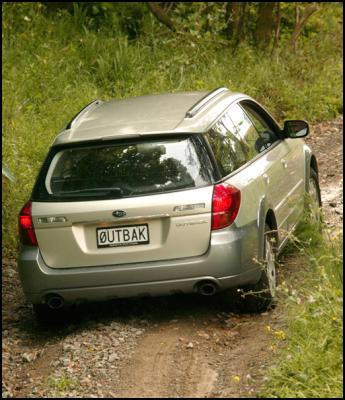
ENDS


 Eugene Doyle: The Fall Of Saigon 1975 - Fifty Years Of Repeating What Was Forgotten
Eugene Doyle: The Fall Of Saigon 1975 - Fifty Years Of Repeating What Was Forgotten Peter Dunne: Dunne's Weekly - Trump's Tariffs Still Pose Risks For New Zealand
Peter Dunne: Dunne's Weekly - Trump's Tariffs Still Pose Risks For New Zealand Keith Rankin: Barbecued Hamburgers And Churchill's Bestie
Keith Rankin: Barbecued Hamburgers And Churchill's Bestie Gordon Campbell: On Why The US Stands To Lose The Tariff Wars
Gordon Campbell: On Why The US Stands To Lose The Tariff Wars Eugene Doyle: Before It’s Too Late - Reimagine New Zealand’s Military Future
Eugene Doyle: Before It’s Too Late - Reimagine New Zealand’s Military Future  Binoy Kampmark: Gender Stunts In Space - Blue Origin’s Female Celebrity Envoys
Binoy Kampmark: Gender Stunts In Space - Blue Origin’s Female Celebrity Envoys